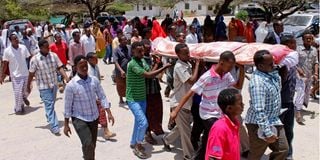Why Somalia struggles with ‘dangerous’ tag for journalists

Somali people carry, on September 21, 2012, the body of Somali journalist Abdisatar Dahir who was killed in a double suicide attack at a restaurant in the centre of Somalia's capital Mogadishu.
Somalia’s labelling as the most dangerous place for journalists continues to endure, even as authorities promised to rework their guard on press freedom.
As the world marked the International Day to End Impunity for Crimes against Journalists, on Wednesday, Somalia was yet again counting the costs of insecurity on free journalism.
Isse Hassan aka Kona a reporter for M24 TV channel was killed on Saturday after a twin bomb explosion caught him and three others near a junction close to the Federal Ministry of Education.
Three other journalists were seriously wounded in an attack Somali government officials say more than 100 people were killed.
Kona and colleagues are said to have been hit by a second explosion as they rushed back to their office to record the events on tape, a local press lobby indicated.
His other colleagues Feisal Omar Hashi, Abdulkadir Mohamed Abdulle and Bile Abdisalan Ahmed; who worked for various international agencies, were seriously wounded.
Isse becomes only the latest figure to be added to the death toll, from Somalia’s insecurity. But according to the National Union of Somali Journalists (NUSOJ), which condemned the attack, the death of Kona means 54 journalists have been killed in Somalia in the past decade, making the country a continual land where journalists are most in danger on the continent.
On Wednesday, Somalia Prime Minister Hamza Abdi Barre issued a statement vowing to defeat al-Shabaab and make Somalia safe for everyone including journalists.
“Without journalists working in a safe and secure environment, Somalia cannot attain the development it aims for,” Barre said on Wednesday to commemorate the UN-sanctioned day which is observed annually on November 2 to draw attention to the level of impunity for crimes against journalists.
“I would like to underscore that those crimes against journalists in all its shapes and forms have no place in Somalia,” he added promising to punish all perpetrators.
In Somalia, however, these promises have been made in the past but not implemented. And a report by NUSOJ on Wednesday said impunity in Somalia has ensured crimes against journalists are overlooked.
Militant group
Several journalists in Somalia have been killed by Al-Shabaab fighters. They were killed for reporting on issues the militant group didn’t like.
In November last year, Abdiaziz Guled aka Afrika, the Director of state-owned Radio Mogadishu was killed in a targeted suicide bombing as he rode in a car with a colleague identified as Sharmarke Mohamed Warsame, the Director of Somali National TV, also a government media outlet.
Afrika had been a veteran of the airwaves and criticised al-Shabaab in a radio show. It marked him out.
Yet government operatives too haven’t been innocent. According to Nusoj, government officials and politicians too have intimidated, threatened or refused to protect journalists. And even when culprits are known, punishment is never close.
“The widespread acceptance of impunity for those who attack journalists in Somalia is, in itself, a major cause for concern. But it also signals a lack of collective political will to tackle the problem head on,” said Omar Faruk Osman, Secretary General of NUSOJ.
Their report titled; Safe to Report – Towards Personal and Professional Safety for Journalists in Somalia, was produced with technical support from the International Labour Organisation. And while it lists the 54 journalists as victims of unsafe environment, it also says there are other subtle challenges for journalists such as cultural blockade on female reporters who have to also endure sexual harassment with nowhere to report.
Also read:
It says: “Women journalists face sexual harassment and assault at the workplaces as well as online harassment. The sexual harassment comes from both male colleagues and the public, creating a particularly toxic working environment for female journalists.”
Those abuses come in the form of “micro aggressions, unwelcome jokes, questions about their private lives, unwanted touching and body shaming.”
“All [these] contribute to workplaces (and broader working environments) that are unsafe,” it says.
In Somalia, the problem is beyond culture and the government has been criticised of refusing to amend archaic laws such as the penal code which are seen as punitive to press freedom and violate international principles.
“Across the country, journalists increasingly face the risk of prosecution as the legal regime is skewed towards control rather than facilitation and protection of journalistic freedoms,” NUSOJ said.
There is hope, however, according to the Somali PM. On Wednesday, he promised to implement the UN, and Somalia’s National Plan of Action on the Safety of Journalists, which would address key challenges that make it unsafe for media practitioners, including legal reform.
The UN Plan was issued in 2012 to tackle impunity after the global body learnt of rising cases of attacks on journalists globally.
Somali journalists hope those reforms will come sooner, including adoption of global laws including ILO standards on occupational safety.
Additional reporting by Aggrey Mutambo




